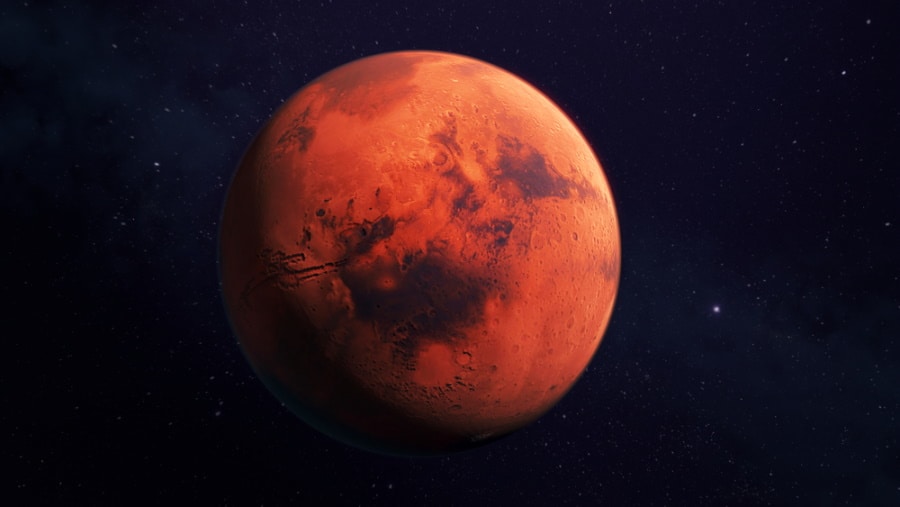How Many Moons Does Mars Have? When Were They Discovered?
Last Updated on

Earth isn’t the only planet with a moon orbiting it. Every planet in the solar system except Mercury and Venus has at least one moon! Mars has two, though that’s just the tip of the iceberg.
Mar’s moons have highly symbolic names, irregular shapes, and tons of other fun facts to learn about them. So, keep reading, as we break down everything that you should know about the moons that orbit Mars!

How Many Moons Does Mars Have?
While some planets have many moons, Mars has two. That’s far fewer than many other planets, but it’s still one more than what Earth has.
That said, when you look at the size of the Martian moons, they’re both significantly smaller than Earth’s Moon. Phobos, the larger of the two Martian moons, has a 7-mile radius, while the radius of Deimos is about 3.8 miles.
For comparison, the Moon orbiting Earth has a radius of 1,079.6 miles! So, while Mars has two moons, the Moon is more than a hundred times larger than both moons combined!

When Did Humans Discover Mars’s Moons?
With the moons around Mars being on the smaller side, it’s not surprising that it took us a little while to discover them.
A scientist named Asaph Hall discovered both moons, and he discovered them just six days apart. Hall discovered the first moon, Deimos, on August 12, 1877, and Phobos on August 18, 1877.
He was spotting objects just 3.8 and 7 miles across while they were millions of miles away, which is impressive!
How Did Mars’s Moons Get Their Names?
Mars got its name from the Roman god of war (known as Ares to the Greeks), so it’s not surprising that when Hall discovered the moons of Mars, he used the same namesake to come up with the names of its moons.
The twin boys of Mars were Phobos and Deimos. Phobos roughly translates to “fear,” while Deimos translates to “dread” or “panic.” They’re heavily symbolic names that go hand in hand with the name Mars!

What Shape Are Mars’s Moons?
While Earth’s Moon is the shape of a slightly flattened ball, the moons around Mars don’t have that consistent shape.
Scientists consider the moons around Mars to be “irregular” in size because they don’t fit any defined shape. Instead, they’re more like any rock that you would pick up when near a mountain. They’re irregular, with bumps and raised portions throughout.
So, imagine one of those rocks, and blow them up to the size of a moon, and that’s roughly what one of Mars’s moons looks like!
When Will Phobos Crash Into Mars?
It’s a known fact that Phobos will eventually crash into Mars or disintegrate under pressure, but how long until that actually happens?
Scientists estimate that it’s going to be around 50 million years from now. Basically, there’s no reason to keep an eye on the red planet to see if it happens anytime soon, but eventually, Phobos is going to have an unfortunate demise.
That said, scientists are still split on whether it will lead to a ring around Mars, which would be a cool sight to see!

Which Planet Has the Most Moons?
While Saturn and Jupiter go back and forth on which one has the most moons, right now, Saturn has a slight edge. According to NASA, Saturn has 82 moons, while Jupiter has 79.
However, it is worth noting that both planets only have 53 confirmed moons; the rest are “provisional” moons. Essentially, they’re “discovered” but are awaiting further confirmation before NASA goes ahead and gives them the official name.

Final Thoughts
While Mars has two moons, they’re both so small that we can hardly see them in the night sky, especially compared to our Moon. Still, they lend themselves to valuable scientific insights about the solar system.
Now that you know more about these moons, the next time that Mars comes into view, pull out a telescope or binoculars and see if you can get a glimpse of Phobos and Deimos as they orbit or transit Mars!
See also:
- How Long Is a Day on Uranus?
- 10 Interesting Facts About Mars
- How Many Rings Does Jupiter Have?
- How Big is Uranus?
Featured Image Credit: joshimerbin, Shutterstock
About the Author Robert Sparks
Robert’s obsession with all things optical started early in life, when his optician father would bring home prototypes for Robert to play with. Nowadays, Robert is dedicated to helping others find the right optics for their needs. His hobbies include astronomy, astrophysics, and model building. Originally from Newark, NJ, he resides in Santa Fe, New Mexico, where the nighttime skies are filled with glittering stars.
Related Articles:
When Were Binoculars Invented? History, Today & Future
15 Crucial Facts About Ultraviolet Rays & the Sun
What Constellation Is Spica In? The Interesting Answer!
10 Interesting Leo Constellation Facts, Myths, and FAQs
15 Interesting Pegasus Constellation Facts, Myths, and FAQs
6 Interesting Sagittarius Constellation Facts, Myths, and FAQs in 2024!
What Are Constellations? Where Did They Come From?
8 Interesting Libra Constellation Facts, Myths, and FAQs
